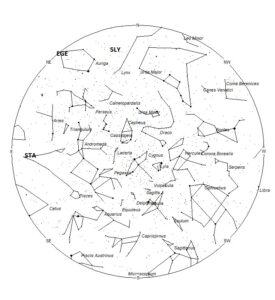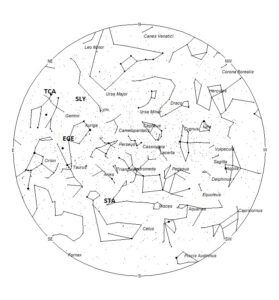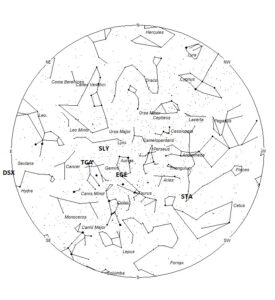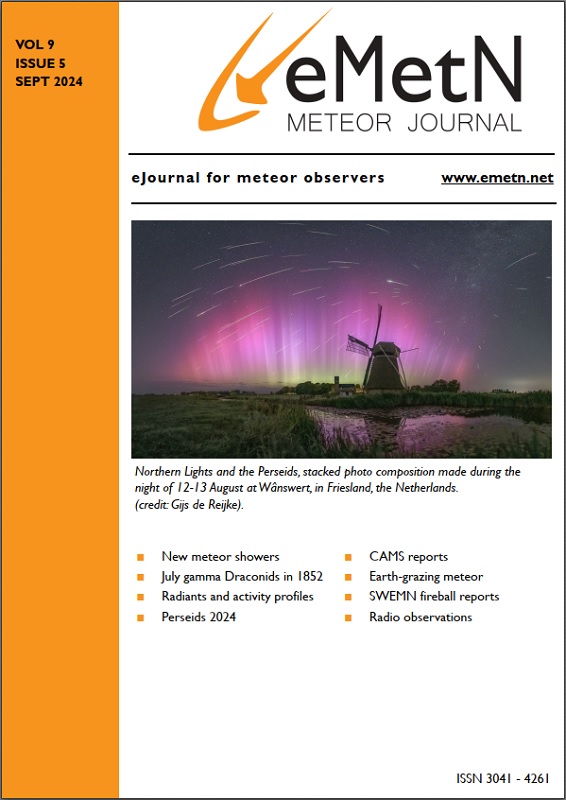Meteor activity increases in October when compared to September. A major shower (the Orionids) is active all month long and there are also many minor showers to be seen. Both branches of the Taurids become more active as the month progresses, providing slow, graceful meteors to the nighttime scene. The Orionids are the big story of the month reaching maximum activity on the 21st. This display can be seen equally well from both hemispheres, which definitely helps out observers located in the sporadic-poor southern hemisphere this time of year. Sporadic activity is still good as seen from the northern hemisphere. In the southern hemisphere though, the sporadic activity is near its annual nadir.
During this period, the moon reaches its new phase on Wednesday October 2nd. At that time the moon will lie near the sun and will not be visible at night. This weekend the waning crescent moon will rise during the morning hours and should not spoil meteor observations as long as you keep it out of your field of view. The estimated total hourly rates for evening observers this weekend should be near 4 as seen from mid-northern latitudes (45N) and 3 as seen from tropical southern locations (25S) For morning observers, the estimated total hourly rates should be near 11 as seen from mid-northern latitudes (45N) and 8 as seen from tropical southern locations (25S). The actual rates seen will also depend on factors such as personal light and motion perception, local weather conditions, alertness, and experience in watching meteor activity. Note that the hourly rates listed below are estimates as viewed from dark sky sites away from urban light sources. Observers viewing from urban areas will see less activity as only the brighter meteors will be visible from such locations.
The radiant (the area of the sky where meteors appear to shoot from) positions and rates listed below are exact for Saturday night/Sunday morning September 28/29. These positions do not change greatly day to day so the listed coordinates may be used during this entire period. Most star atlases (available at science stores and planetariums) will provide maps with grid lines of the celestial coordinates so that you may find out exactly where these positions are located in the sky. I have also included charts of the sky that display the radiant positions for evening, midnight, and morning. The center of each chart is the sky directly overhead at the appropriate hour. These charts are oriented for facing south but can be used for any direction by rotating the charts to the desired direction. A planisphere or computer planetarium program is also useful in showing the sky at any time of night on any date of the year. Activity from each radiant is best seen when it is positioned highest in the sky, either due north or south along the meridian, depending on your latitude. Radiants that rise after midnight will not reach their highest point in the sky until daylight. For these radiants, it is best to view them during the last few hours before dawn. It must be remembered that meteor activity is rarely seen at its radiant position. Rather they shoot outwards from the radiant, so it is best to center your field of view so that the radiant lies toward the edge and not the center. Viewing there will allow you to easily trace the path of each meteor back to the radiant (if it is a shower member) or in another direction if it is sporadic. Meteor activity is not seen from radiants that are located far below the horizon. The positions below are listed in a west to east manner in order of right ascension (celestial longitude). The positions listed first are located further west therefore are accessible earlier in the night while those listed further down the list rise later in the night.

Radiant Positions at 21:00 Local Summer Time

Radiant Positions at 01:00 Local Summer Time

Radiant Positions at 05:00 Local Summer Time
These sources of meteoric activity are expected to be active this week
.
We are now encountering inbound debris from comet 2P/Encke, which has its source superimposed upon the anthelion radiant. Since it has been shown that meteors from 2P/Encke are more numerous than the Anthelions, we will recognize this activity as the Southern Taurids (STA) from now until late November, when we no longer encounter remnants from comet 2P/Encke. Like the anthelion radiant, the source area is large and diffuse so observers can be liberal with the shower association of these meteors. Recent investigations of the Southern Taurids have revealed two clearly distinct components. The first component, also known as the October Arietids, represents the early and annual activity of Southern Taurids. It displays very little variation year to year. The latter component represents the main source of activity and is periodic. The early STA’s are active from September 28 through November 2 and peaks on October 14th. The main component of the STA’s are active from October 12 through November 27 and peaks on November 5th. The center of the large STA radiant is currently located at 01:43 (026) +06. This position lies in southeastern Pisces, 1 degree northeast of the 4th magnitude star known as nu Piscium. This radiant is best placed near 02:00 local summer time (LST), when it lies on the meridian and is located highest in the southern sky. Rates at this time should be near 3 per hour no matter your location. With an entry velocity of 30 km/sec., the average STA meteor would be of medium-slow velocity.
The epsilon Geminids (EGE) are active from September 27th through November 7th with maximum activity occurring on October 16th. The radiant is currently located at 05:37 (084) +30. This area of the sky lies in southern Auriga, 2 degrees northeast of the 2nd magnitude star known as El Nath (beta Tauri). To best see these meteors, face toward the east during the last dark hour prior to dawn. Rates at this time should be less than 1 per hour no matter your location. With an entry velocity of 70 km/sec., the average EGE meteor would be of swift velocity.
The September Lyncids (SLY) are composed of two weak showers active throughout September. The later branch is active from September 16th through October 3rd with maximum activity occurring on September 28th. The radiant is located at 07:28 (112) +48, This position lies in central Lynx, 2 degrees south of the pair of faint stars known as 21 and 22 Lyncis. To best see these meteors, view toward the northeastern sky during the last few hours prior to dawn. Rates are expected to be less than 1 per hour. With an entry velocity of 66 km/sec., the average meteor from this source would be of swift velocity.
The tau Cancrids (TCA) are a weak shower with a long activity period of seven weeks. They are active from September 27 through November 12 with maximum activity occurring on October 22nd. The radiant currently lies at 07:52 (118) +29, which places it in northeastern Gemini, 1 degree northeast of the 1st magnitude star known as Pollux (beta Geminiorum). To best see these meteors face eastward during the last hours of the morning prior to dawn. Expected hourly rates are less than 1 per hour no matter your location. With an entry velocity of 67 km/sec., the average TCA meteor would be of swift velocity.
The Daytime Sextantids (DSX) are active from September 22-October 13, with maximum activity occurring on October 1st. The current position of the radiant is 10:12 (153) -02. This position lies in central Sextans, 2 degrees southeast of the 4th magnitude star known as alpha Sextantis. Rates at this time should be less than 1 per hour no matter your location. With an entry velocity of 33 km/sec., the average DSX meteor would be of medium-slow velocity. No matter your location, these meteors are difficult to observe as the radiant lies roughly 30 degrees from the sun. Therefore, these meteors may only be seen during the last hour prior to dawn, shooting upward from the eastern horizon.
Sporadic meteors are those meteors that cannot be associated with any known meteor shower. All meteor showers are evolving and disperse over time to the point where they are no longer recognizable. Away from the peaks of the major annual showers, these sporadic meteors make up the bulk of the activity seen each night. As seen from the mid-northern hemisphere (45N) one would expect to see during this period approximately 10 sporadic meteors per hour during the last hour before dawn as seen from rural observing sites. Evening rates would be near 3 per hour. As seen from the tropical southern latitudes (25S), morning rates would be near 7 per hour as seen from rural observing sites and 2 per hour during the evening hours. Locations between these two extremes would see activity between these listed figures.
The list below offers the information in tabular form of the showers that I feel are within reach of the visual observer to discern. Hourly rates are often less than one, so these sources are rarely listed as visual targets in most meteor shower lists. If you are like me and wish to associate as many meteors as possible with known sources, then you will appreciate these listings. Before listing meteors from these obscure sources, you should attempt to prove these meteors belong to them and are not chance alignments of sporadic meteors. You can note parameters such as duration, length, radiant distance and the elevation of each meteor to help compute the probability of shower association. It should be remembered that slow meteors can be seen from fast showers, but fast meteors cannot be produced from slow showers. Slower showers are those with velocities less than 35/km per second. Slow meteors can appear from fast showers when they appear close to the radiant or low in the sky. The table located on page 22 of the IMO’s 2024 Meteor Shower Calendar is a big help in aiding in the identification of meteors. If you record the length and duration of each meteor, you can use this chart to check the probability of the meteor belonging to a shower of known velocity. If the angular velocity is similar to the figure in the table, then your meteor probably belongs to that shower. Rates and positions are exact for Saturday night/Sunday morning.
| SHOWER | DATE OF MAXIMUM ACTIVITY | CELESTIAL POSITION | ENTRY VELOCITY | CULMINATION | HOURLY RATE | CLASS |
| RA (RA in Deg.) DEC | Km/Sec | Local Summer Time | North-South | |||
| Southern Taurids (STA) | Nov 05 | 01:16 (019) +05 | 27 | 02:00 | 1 – 1 | II |
| epsilon Geminids (SPE) | Oct 16 | 05:37 (084) +30 | 70 | 06:00 | <1 – <1 | II |
| September Lyncids (SLY) | Sep 28 | 07:28 (112) +48 | 66 | 08:00 | <1 – <1 | IV |
| tau Cancrids (TCA) | Oct 22 | 07:52 (118) +29 | 67 | 08:00 | <1 – <1 | IV |
| Daytime Sextantids (DSX) | Oct 01 | 10:12 (153) -02 | 33 | 10:00 | <1 – <1 | IV |
You can keep track of the activity of these meteor showers as well as those beyond the limits of visual observing by visiting the NASA Meteor Shower Portal. You can move the sky globe to see different areas of the sky. Colored dots indicate shower meteors while white dots indicate sporadic (random) activity. The large orange disk indicates the position of the sun so little activity will be seen in that area of the sky.
Class Explanation: A scale to group meteor showers by their intensity:
- Class I: the strongest annual showers with Zenith Hourly Rates normally ten or better.
- Class II: reliable minor showers with ZHR’s normally two to ten.
- Class III: showers that do not provide annual activity. These showers are rarely active yet have the potential to produce a major display on occasion.
- Class IV: weak minor showers with ZHR’s rarely exceeding two. The study of these showers is best left to experienced observers who use plotting and angular velocity estimates to determine shower association. These weak showers are also good targets for video and photographic work. Observers with less experience are urged to limit their shower associations to showers with a rating of I to III.



